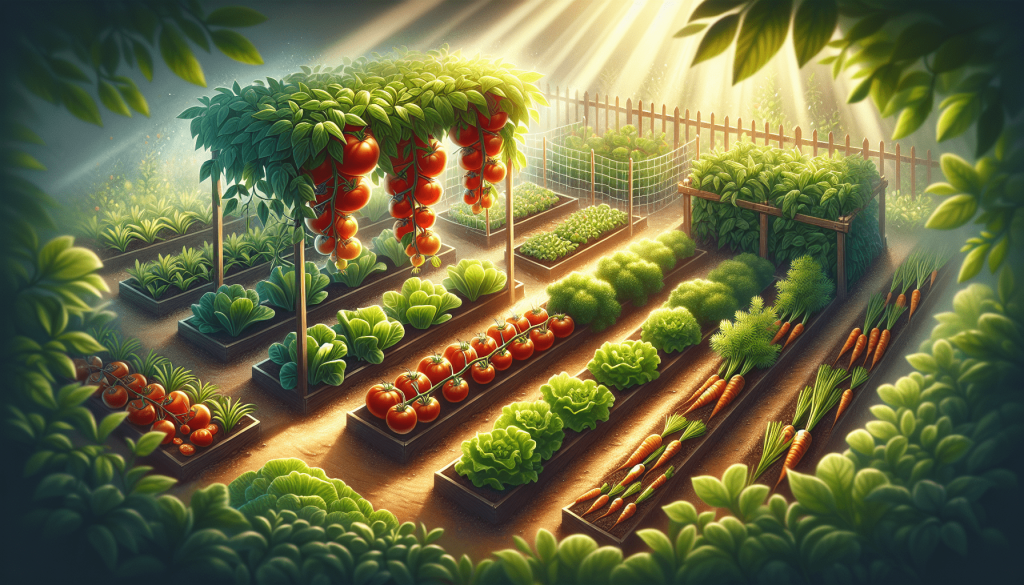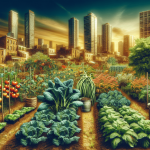This post may contain affiliate links. As an Amazon Associate, we may earn commissions from qualifying purchases.
Are you looking to keep your small vegetable garden healthy and productive year after year? Implementing crop rotation is a fantastic way to boost soil fertility and ward off pests and diseases. In this article, you’ll discover practical tips and strategies to effectively rotate your crops, even in a limited space. With just a bit of planning and knowledge, you can optimize the yield and health of your garden, ensuring a bountiful harvest season after season. How Can I Implement Crop Rotation In A Small Vegetable Garden?
Have you ever stared at your small vegetable garden and wondered how to make it thrive? Maybe you’ve planted your tomatoes in the same spot year after year, only for them to give you the stink eye from the vine, knowing they deserve better. You see, crop rotation isn’t just for large-scale farmers; it’s a practice even the modest home gardener can, and should, adopt. Buckle up, dear gardening enthusiast, because we’re about to delve into the nitty-gritty of crop rotation in small vegetable gardens.
What is Crop Rotation and Why Does It Matter?
So, what is this crop rotation thing everyone keeps harping about? Well, it’s a systematic way of planting your vegetables in different sections of your garden each year. The primary goal is to avoid planting the same family of vegetables in the same spot consecutive years. This may sound like vegetable musical chairs, but it keeps your garden happier and healthier.
Benefits of Crop Rotation
You must be wondering why you should go through all this trouble. Well, crop rotation offers a multitude of benefits, such as:
- Disease Prevention: Rotating crops helps break the life cycles of pests and diseases. If you plant the same crop in the same spot year after year, pathogens can build up and wreak havoc.
- Soil Health: Different plants have different nutrient requirements. Rotating crops can help prevent nutrient depletion and improve soil structure.
- Weed Control: Some crops suppress weeds better than others. By rotating, you can manage weeds more effectively.
Getting Started with Crop Rotation
Before you jump into action, a bit of planning is required. This is where you grab your favorite notebook or gardening app and start sketching.
Assess Your Garden Space
First things first, take a good look at your garden. Whether it’s a few raised beds or a collection of pots on your balcony, knowing what you’ve got to work with will inform all your next steps.
Group Your Plants
Did you know that plants can be divided into families based on similar characteristics? It’s like a high school reunion, but with fewer awkward moments. Understanding these families is crucial for effective crop rotation. Here’s a quick rundown of common vegetable families:
| Family | Common Vegetables | Key Characteristics |
|---|---|---|
| Nightshade | Tomatoes, Peppers, Eggplants, Potatoes | Susceptible to early blight |
| Brassicas | Cabbage, Broccoli, Kale, Cauliflower | Heavy feeders, need rich soil |
| Legumes | Beans, Peas | Nitrogen-fixing |
| Cucurbits | Squash, Cucumbers, Melons | Susceptible to cucumber beetles |
| Alliums | Onions, Garlic, Leeks | Susceptible to onion maggots |
| Umbellifers | Carrots, Parsnips, Celery | Attract beneficial insects |
| Asteraceae | Lettuce, Sunflowers, Artichokes | Generally shallow-rooted |
By dividing your crops into these families, you can start rotating them efficiently.

Practical Steps to Implement Crop Rotation
Now that your garden space is assessed and your plants grouped into families, let’s move on to the actual implementation. Here’s where the rubber meets the road, or where the roots meet the soil, if you prefer.
Create a Planting Plan
Think of this as your garden’s seating chart, minus the social drama. In your notebook or app, draw a layout of your garden space and start mapping out where each plant family will go for the first year.
Develop a Rotation Schedule
Since your garden is small, a basic 3- or 4-year rotation plan should suffice. The goal here is to avoid planting any plant family in the same spot for at least three years. If you’re working with raised beds or containers, rotating becomes even easier, as you can simply shift the pots or planters around.
Here’s an example of a 4-year crop rotation schedule:
| Year | Bed 1 | Bed 2 | Bed 3 | Bed 4 |
|---|---|---|---|---|
| 1 | Legumes | Brassicas | Nightshades | Root Vegetables |
| 2 | Brassicas | Nightshades | Root Vegetables | Legumes |
| 3 | Nightshades | Root Vegetables | Legumes | Brassicas |
| 4 | Root Vegetables | Legumes | Brassicas | Nightshades |
Adjust for Seasonality
Remember that some plants are cool-season crops (like lettuce and broccoli), while others are warm-season crops (like tomatoes and peppers). Incorporate this into your plan so that you aren’t stuck waiting for frost-sensitive plants to be harvested before you can plant your next crop.
Record Keeping
I can’t stress this enough: keep records. Good records are the secret sauce to successful crop rotation. Jot down what you planted where and any issues you encountered. Over time, this information will become a goldmine for improving your garden.
Troubleshooting Common Challenges
The best-laid plans of mice and men often go awry, and the same can be said of the best-laid garden plans. You’ll inevitably face challenges along the way, so let’s troubleshoot some common snafus.
Limited Space
“But my garden is tiny!” you holler from your patio, shaking a trowel at the sky. Fear not; where there’s a will, there’s a way. If space is limited, focus more on container gardening. Rotating crops in containers is as simple as rotating the containers themselves.
Overlapping Growing Seasons
Sometimes, your perfect plan hits a snag when your summer crops refuse to vacate their beds in time for the fall rotation. In such cases, you might practice intercropping or relay planting, where you start the new crops beside the old ones as they finish up.
Pests and Diseases
Even with rotation, it’s impossible to eradicate all pests and diseases. Complement your crop rotation strategy with other practices like companion planting, using organic pesticides, or introducing beneficial insects.
Soil Fertility
Different plants deplete different nutrients from the soil. While rotation helps manage this, adding compost and organic fertilizers can further maintain your soil’s health. Use a soil test kit every couple of years to monitor soil health and plan amendments accordingly.

The Joy of Discovering Perennial Vegetables
It’s like finding out your favorite song on the radio is actually part of an entire album. Introducing perennials like asparagus and rhubarb to your garden can provide long-term value and reduce the need for constant rotation. Just plant them in a permanent spot and let them do their thing.
Integrating Crop Rotation with Other Gardening Techniques
Don’t view crop rotation in isolation; it’s part of a larger gardening toolkit. Combine it with other methods to get the best out of your garden.
Companion Planting
Planting basil next to your tomatoes might make a delicious dinner, but did you know it can also improve the health of both plants? Companion planting pairs plants that benefit each other, enhancing growth and deterring pests. Here’s how you can integrate it with crop rotation:
| Crop | Companion Plant | Benefits |
|---|---|---|
| Tomatoes | Basil | Protects against pests, improves flavor |
| Carrots | Onions | Deters carrot flies |
| Beans | Corn | Provides natural trellis, fixes nitrogen |
Cover Cropping
When your garden beds are not in use (usually during winter), plant cover crops like clover or rye. These crops enrich the soil, prevent erosion, and can be tilled back into the soil to add organic matter.
Organic Practices
Embrace organic gardening to support your crop rotation strategy. No synthetic chemicals means you’re protecting soil microorganisms and beneficial insects—sidekicks you’ll want in your gardening journey.
Wrapping Up: The Long-Term Vision
Implementing crop rotation in your small vegetable garden might seem daunting at first, but as with any worthwhile endeavor, it gets easier with practice. Think of it as an investment, much like watering your plants or avoiding your neighbor who loves to talk too much about his lawn—small steps can lead to big rewards.
Review and Adjust
Gardens are dynamic, living systems that may not always follow your embroidered plans to the letter. Review and adjust your crop rotation schedules as needed, and keep an eye on your garden’s health. Flexibility is your friend here.
Enjoy the Fruits (and Vegetables) of Your Labor
At the end of the gardening season, when you’re holding that perfectly plump tomato or that crisp head of lettuce, take a moment to appreciate the benefits of your hard work. Crop rotation isn’t just about managing soil and pests—it’s about sustaining a thriving, dynamic garden that rewards you year after year.
So, the next time you step into your small vegetable garden, remember you’re not just planting seeds; you’re planting a legacy of good gardening practices that will serve you (and your taste buds) well. Happy rotating!








